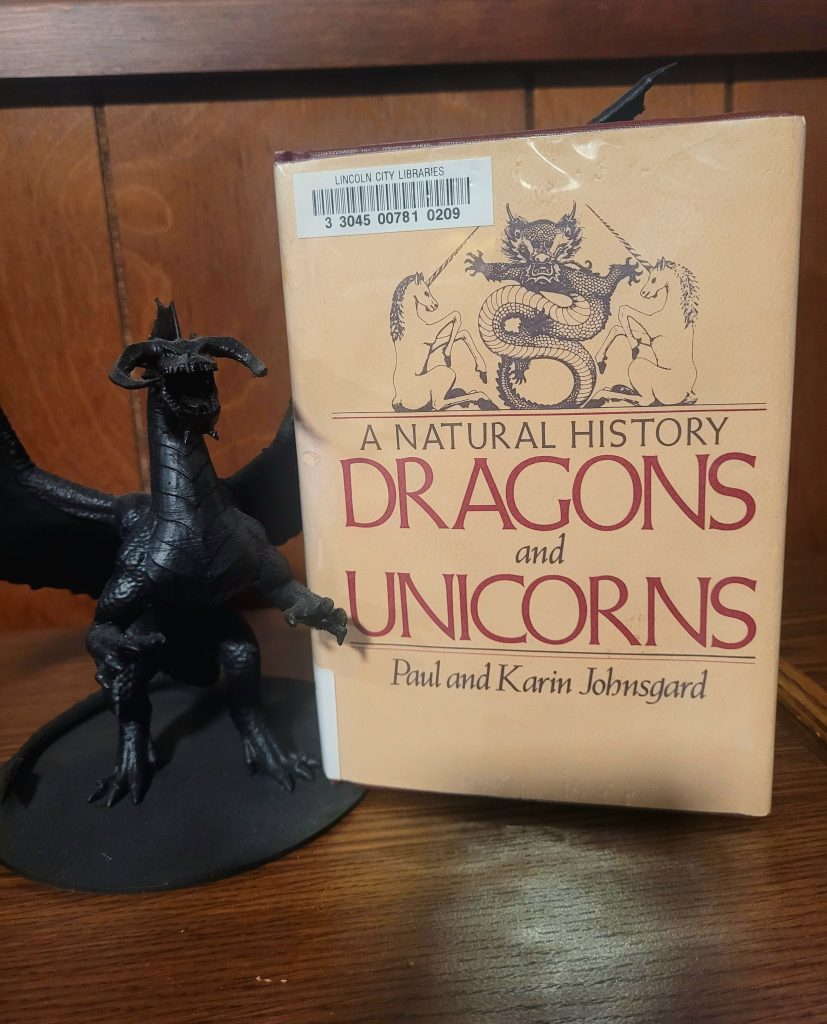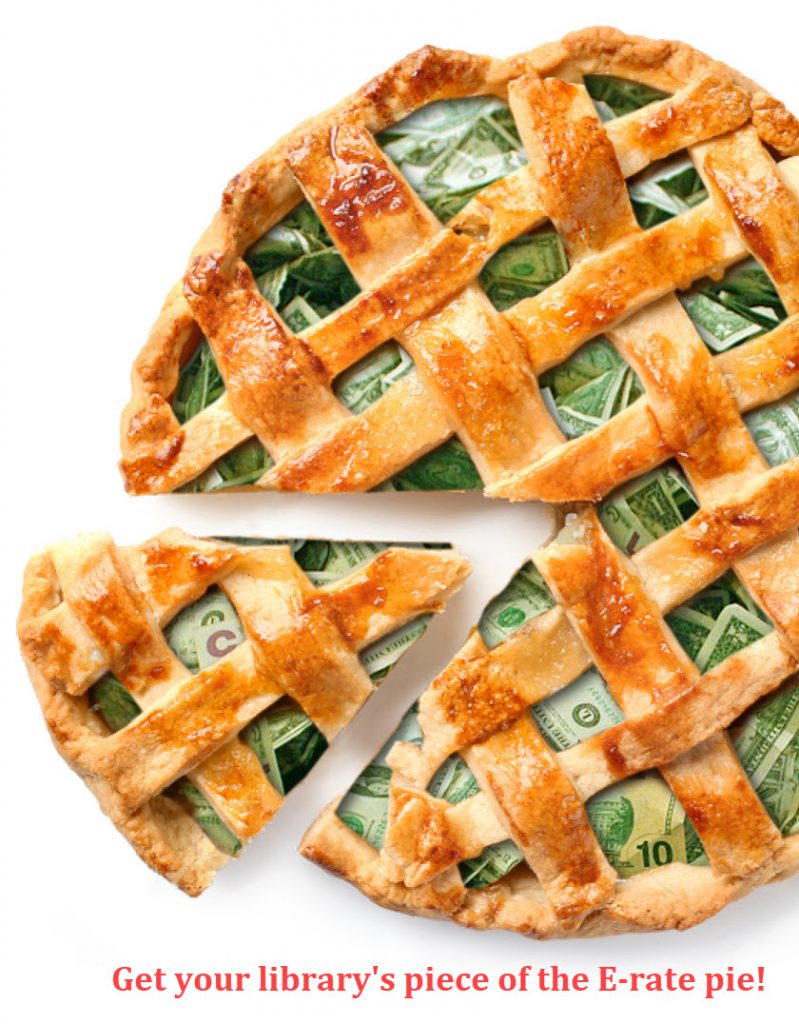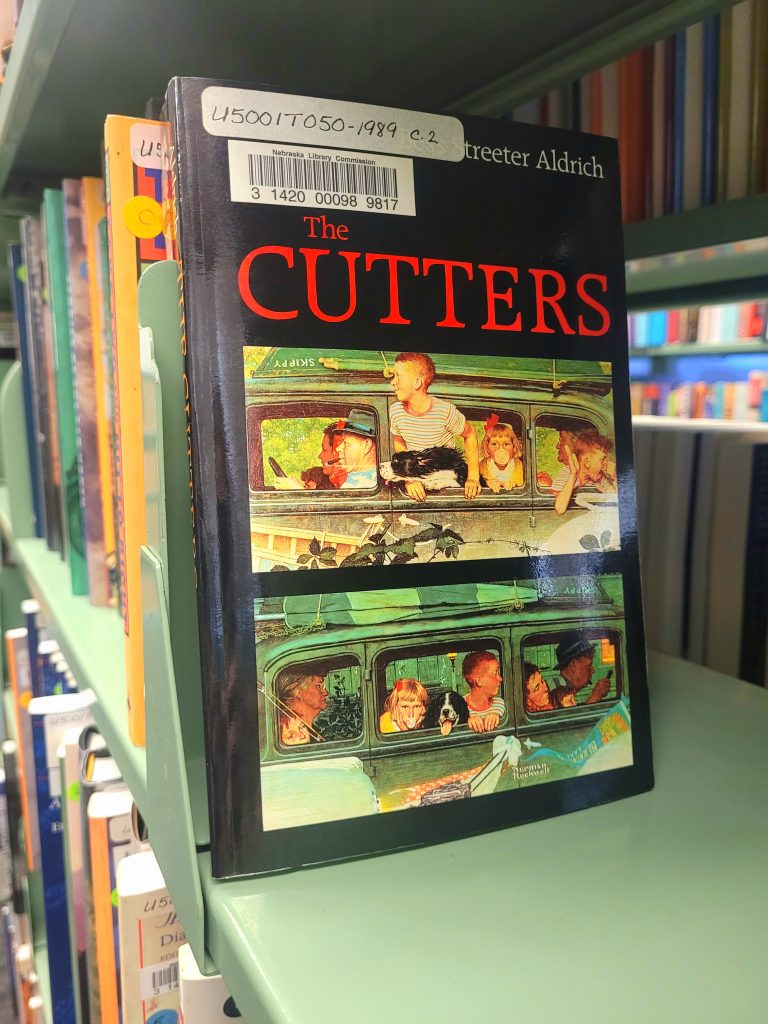Search the Blog
Categories
- Books & Reading
- Broadband Buzz
- Census
- Education & Training
- Friday Reads
- General
- Grants
- Information Resources
- Library Management
- Nebraska Center for the Book
- Nebraska Libraries on the Web
- Nebraska Memories
- Now hiring @ your library
- Preservation
- Pretty Sweet Tech
- Programming
- Public Library Boards of Trustees
- Public Relations
- Talking Book & Braille Service (TBBS)
- Technology
- Uncategorized
- What's Up Doc / Govdocs
- Youth Services
Archives
Subscribe
Category Archives: General
Throwback Thursday: Edwin Lyndon May Jr. and Dog
This #ThrowbackThursday is extra adorable!

This 4″x6″ glass plate negative is a portrait photograph of Edwin Lyndon “Ned” May Jr. and a small dog. Edwin was born in Nebraska, December 15, 1904, and the photograph is dated October 16, 1906 making him just under two years old in the portrait. He was the son of Edwin and Jennette May, and according to the 1920 census, the family was living in Beatrice, Nebraska, where his parents ran a hotel. Later in life Edwin married Evelyn Johnson on October 8, 1942, in Jackson County, Missouri. He died at the age of 89 on May 9, 1994, in Pierce, Nebraska.
This image is published as part of the Boston Studio Project collection, and is owned by both them and the Thorpe Opera House Foundation. The Boston Studio Collection consists of over 68,000 negatives that record life in and around David City, Nebraska from 1893 to 1979.
See this collection and many more on the Nebraska Memories archive!
The Nebraska Memories archive is brought to you by the Nebraska Library Commission. If your institution is interested in participating in Nebraska Memories, see http://nlc.nebraska.gov/nebraskamemories/participation.aspx for more information.
NLC Staff: Meet Andrew “Sherm” Sherman
Questions and answers with NLC’s Library Technology Support Specialist, Andrew Sherman AKA Sherm, who started working with us in December 2022. Take a few minutes and get to know him with a few fun questions!
What was the last thing you googled?
MapQuest to plan a trip to multiple libraries
What advice would you give your 21 year old self?
You never stop learning and you’ll be much happier if you embrace change
What’s your ideal vacation?
Hiking in the mountains or lying on a beach
What do you do to relax?
Reading, playing video games, and streaming shows at home – currently Fallout on Prime
Describe your first car:
A sweet 1967 Competition Orange Mustang Coupe with chrome Cragar wheels that my twin brother and I bought and shared.
If I weren’t working in a library, I’d be …
Working as an IT Professional
What was the first concert you remember attending?
Black Sabbath
What movie can you watch over and over again?
Galaxy Quest
What was the last book you read?
A Fire Upon the Deep by Vernor Vinge
What was the last movie you watched?
Barbie on Max
What is a quote you live by?
“Knowing is not enough; we must apply. Being willing is not enough; we must do.”
– Leonardo da Vinci
What is your proudest handyman moment?
Full kitchen and bathroom remodels of my homes
What phrase describes you?
Git-R-Done!
What smell brings back great memories?
My mom’s chocolate chip cookies
If you could have one superpower what would it be?
The ability to fly
What’s the last thing you do before you go to bed?
Plug in my phone and put it on the nightstand
If you had a warning label, what would it say?
Patient to a point then Boom
Do you have any tattoos?
No
What is your favorite comfort food?
Just like the song. “I like mine with lettuce and tomata, Heinz 57 and french fried potatas. A big kosher pickle and a cold draft beer. Well good God almighty which way do I steer?!” Cheeseburger in Paradise by Jimmy Buffett
What words or phrases do you overuse?
Sweet! and Cool!
What’s your most treasured possession?
Memories of vacations with my family
On what occasion do you lie?
Answering I’m fine when people constantly asked me how I was doing after losing my 1st wife to breast cancer.
What posters did you have on your wall as a kid?
Stevie Nicks (love her!) and other singers and bands as they came and went
Do you love or hate rollercoasters?
LOVE
Do you have any pets?
A corgi named Baxter and three cats named Minnie, Lucius, and Umbra
What is your guilty pleasure?
Ice cream
Favorite technology you could not live without?
My smartphone
If you could get rid of one holiday – which one would you abolish?
I enjoy all of the holidays
If you could only eat one kind of food for the rest of your life, what would it be?
Pizza
If you could call anyone in the world and have a one-hour conversation, who would you call?
David Whyte – the author of Consolations: The Solace, Nourishment and Underlying Meaning of Everyday Words. His book was very comforting while grieving.
Posted in General, Public Relations
Tagged Nebraska Library Commission Staff, NLC Staff, Staff
Leave a comment
Friday Reads & BookFace Friday: “Making It So” by Patrick Stewart
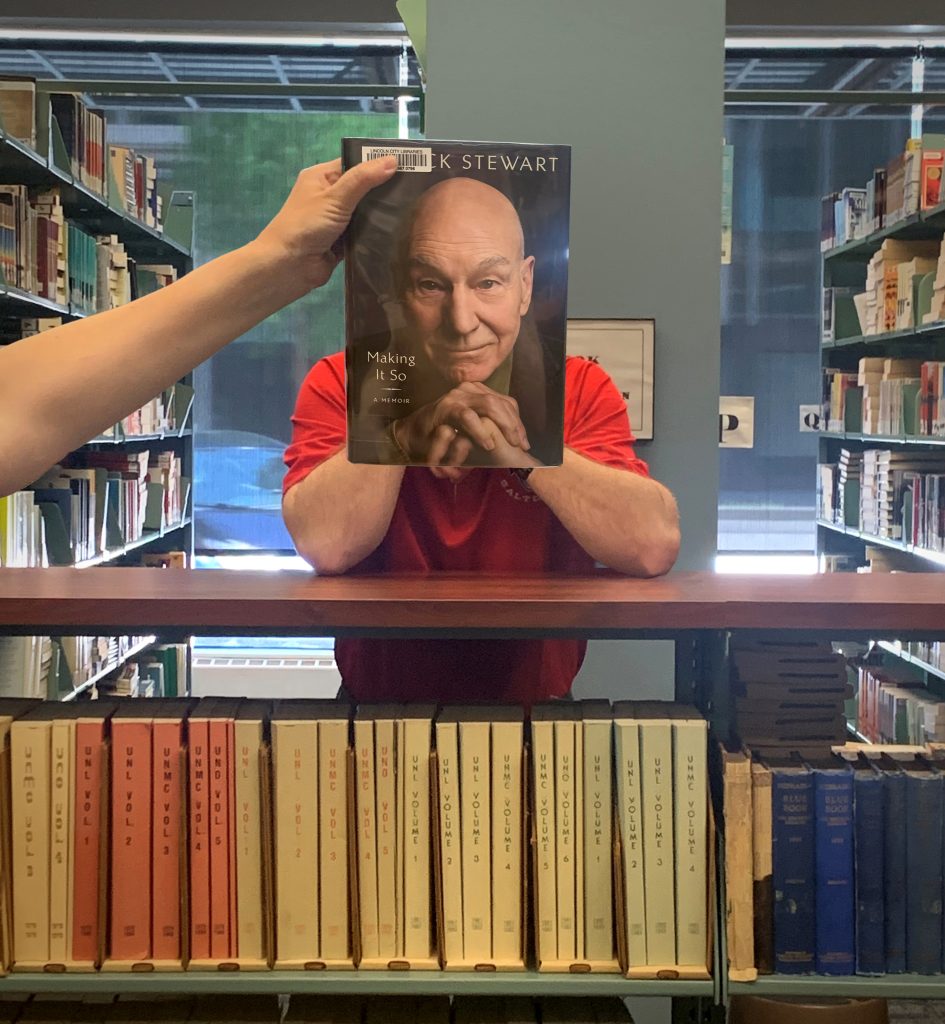
I remember watching and enjoying Star Trek: The Next Generation, starring Patrick Stewart as Jean-Luc Picard, but I wouldn’t call myself a diehard Trekkie. That was no barrier to finding Making It So, Stewart’s recently released memoir, enchanting and delightful. Especially the Audie award-winning audio edition, narrated by Stewart, himself.
As you can imagine, he declaims every word of every sentence with gusto!Stewart (b. 1940) starts at the beginning, describing what it was like growing up working class in Yorkshire in the 1940s and early 1950s. This includes a brief etymology lesson on the Yorkshire dialect he grew up speaking, which, according to Stewart, would have been “nearly incomprehensible to Londoners, let alone Americans.” For instance, he explains that “ata,” which meant “are you,” descended from “art though”; “nowt” meant “nothing”; “Geroff!” meant “leave me alone”; and a chamber pot was a “gazunder,” because it “goes under” the bed. This is relevant since in order to become an actor he had to learn “received pronunciation,” or “RP.” (RP was the standard pronunciation used by BBC broadcasters back in the day.)
Stewart also does a good job conveying the degree to which theater permeated English society at the time. It ranged from amateur dramatics (“am-drams”) at the local level, to a network of regional repertory theaters, all the way up to the Royal Shakespeare Company in Stratford-upon-Avon and the National Theatre in London. And thanks to financial support by the government in the form of grants and scholarships, it was accessible to all—even a working-class boy like Stewart, who got his start locally and then worked his way to the top.
If you are particularly interested in the Star Trek: Next Generation portion of this memoir, you’ll have to be patient, or skip to chapter 16. From there on out (there are a total of 25 chapters in the book), you will be rewarded with lots of insider, behind-the-scenes information about Stewart’s time as Picard. There are also plenty of details about his stint as Charles Xavier in the X-Men movie franchise, and voice work for Seth MacFarlane’s Family Guy and American Dad, as well as other television, film, theater, and social media projects he’s participated in, including reciting all Shakespeare’s sonnets on Instagram during the pandemic lockdown.
While this memoir will appeal to Trekkies, theater nerds, and Anglofiles, there are also elements that will resonate with anyone who has lived a long life filled with both gratitude and regret. In later chapters, Stewart expresses remorse over the demise of his 23-year marriage to his first wife, and the damage that did to his relationship with their children, Daniel and Sophie: “[T]he hurt caused by my split with their mother has never fully gone away,” he writes. After a second brief marriage falls apart, he laments: “And so, another divorce. I felt stupid and responsible.” But he also joyfully expounds on life with his third wife, Sunny Ozell, to whom he’s been married since 2013, as well as his well-publicized friendship with Ian McKellen. Overall, Stewart comes across as a vibrant, engaged octogenarian who, despite living a full, rich life, is still ready for more!
Stewart, Patrick. Making It So: A Memoir. Gallery Books, 2023.
You can find “Making It So: A Memoir” by Patrick Stewart as an eBook in Nebraska OverDrive Libraries! Libraries participating in the Nebraska OverDrive Libraries Group currently have access to a shared and growing collection of digital downloadable audiobooks and eBooks. 194 libraries across the state share the Nebraska OverDrive collection of 26,174 audiobooks, 36,611 ebooks, and 5,210 magazines. As an added bonus it includes 130 podcasts that are always available with simultaneous use (SU), as well as SU ebooks and audiobook titles that publishers have made available for a limited time. If you’re a part of it, let your users know about this great title, and if you’re not a member yet, find more information about participating in Nebraska Overdrive Libraries!
Love this #BookFace & Friday Reads? We suggest checking out all the titles available in our Book Club collection, permanent collection, and Nebraska OverDrive Libraries. Check out our past #BookFaceFriday photos on the Nebraska Library Commission’s Facebook page!
Posted in Books & Reading, General
Tagged Book Covers, bookface, bookfacefriday, Ebook, Friday Reads, Making It So, Memoir, Nebraska OverDrive Libraries, Patrick Stewart, Reading
Leave a comment
Throwback Thursday: The Rose Bower at Hanscom Park
Remember to stop and smell the roses on this #ThrowbackThursday!
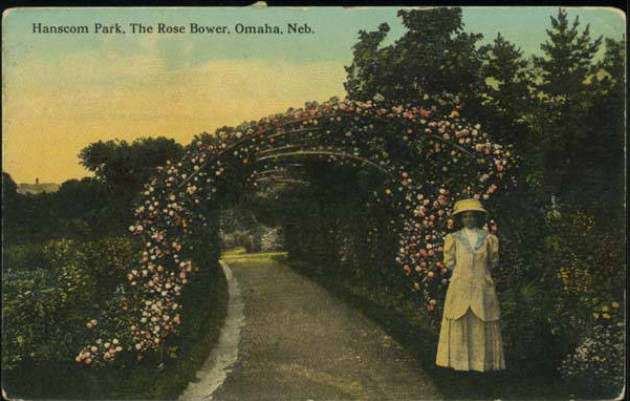
This 13.5 x 8.5 cm color postcard shows a lovely view of a rose bower at Hanscom Park, one of Omaha’s oldest parks. The 50-acre tract was donated to the city in 1872 by Andrew J. Hanscom and James Megeath. There is a long bower covered in pink roses with a woman standing to the right in an off-white skirt, jacket and hat. The reverse is postmarked 1912 over a one cent stamp featuring Benjamin Franklin in profile (attached upside down) along with a handwritten message:
Postmark 1912
Miss Veda Wenstrand
Essex
Iowa
Rt #3
Hello how you was I am fine and dandy what are you doing now days I am working hard all the time are you coming down this way sun will are you game [unreadable due to fading writing] I am game all the time [unreadable]
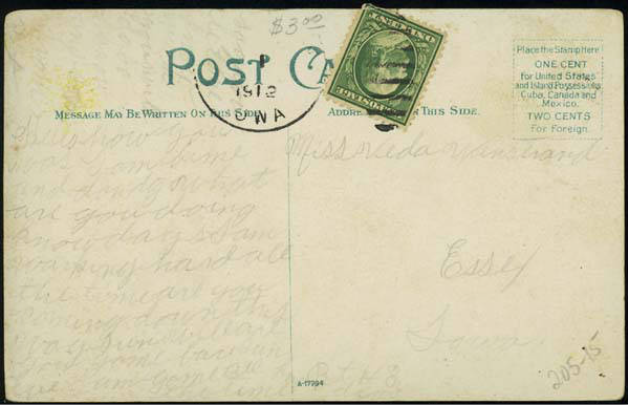
This image is published and owned by the Omaha Public Library. They have a large collection of 1,100+ postcards and photographs of the Omaha area.
See this collection and many more on the Nebraska Memories archive!
The Nebraska Memories archive is brought to you by the Nebraska Library Commission. If your institution is interested in participating in Nebraska Memories, see http://nlc.nebraska.gov/nebraskamemories/participation.aspx for more information.
Posted in General, Nebraska Memories, Preservation
Tagged Color postcards, Hanscom Park, Omaha, Omaha Public Library, Throwback Thursday
Leave a comment
#BookFaceFriday “Two Tribes” by Emily Bowen Cohen
This #BookFaceFriday is the best of both worlds!
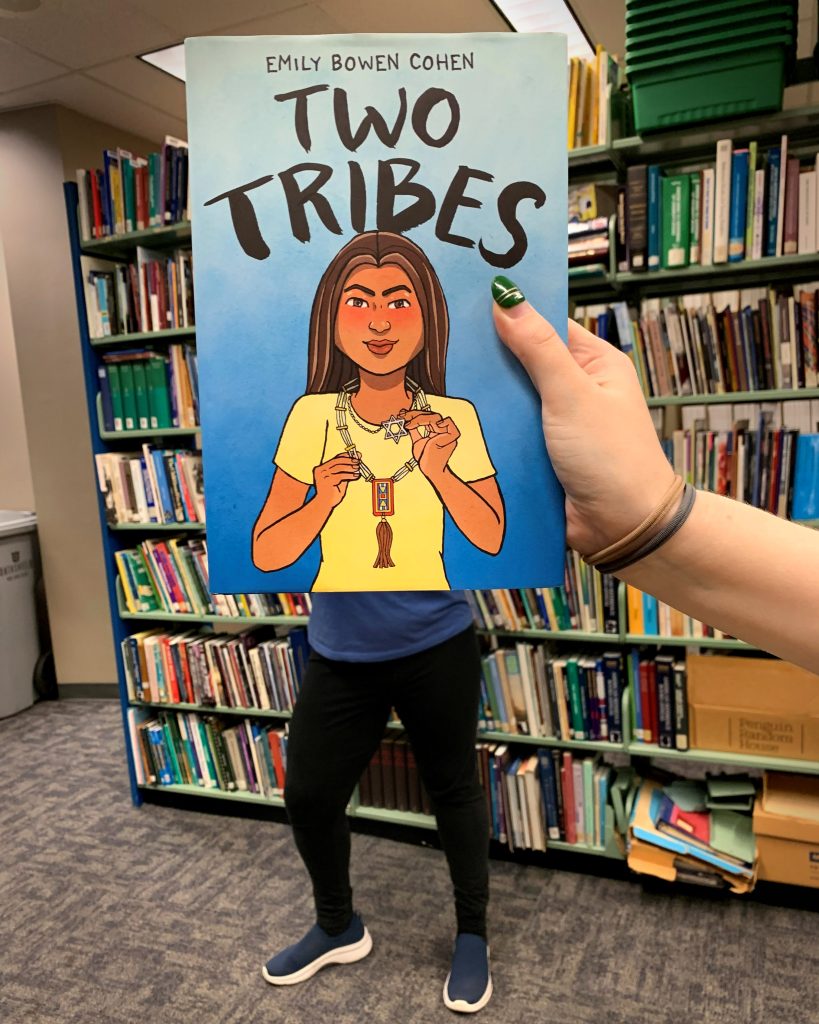
It’s a picture perfect #BookFace, with “Two Tribes” by Emily Bowen Cohen (Heartdrum, 2023) it is a graphic novel geared towards YA or tween readers based on the author’s real life. You can hear all about it on our Children and Young Adult Library Services Coordinator, Sally Snyder’s, “Best New Teen Reads of 2023” NCompass Live presentation. You can watch the recording and find out all about her book lists on the NCompass Live webpage. In this episode, Sally and Dana Fontaine, Fremont High School Librarian, give brief book talks and reviews of new titles recommended to school and public librarians, covering both middle and high school levels, that were published within the last year.
“In Mia’s struggle to reconcile her ancestries, the creator develops a credible portrayal of self-image and acceptance. Plentiful panels rendered in earth tones further enhance this nuanced portrait of Mia’s search for identity.”
—Publishers Weekly
Love this #BookFace & reading? Check out our past #BookFaceFriday photos on the Nebraska Library Commission’s Facebook page!
Friday Reads: Atlantis, by David Gibbins
I am a huge fan of adventure novels and movies, so over the years I have really enjoyed the various books of Clive Cussler, Steve Berry, Dan Brown, David Baldacci, and Lee Child. An action/adventure author that I hadn’t read, David Gibbins, popped up on my radar recently, so I decided to try his first novel in the Jack Howard series, Atlantis, and it did not disappoint! Atlantis was written in 2005, and there are now 11 books in the series , so I’m really looking forward to reading the next one!
Archaeologist Jack Howard is a brave but cautious man. When he embarked on a new search for buried treasure in the Mediterranean, he knew it was a long shot. When he uncovered a golden disc that spoke of a lost civilization more advanced than any in the ancient world, he started to get excited. But when Jack Howard and his intrepid crew finally got close to uncovering the secrets the sea had held for thousands of years, nothing could have prepared them for what they would find in the murky depths – not only a shocking truth about a lost world but an explosive secret that could have devastating consequences today. Jack is determined to stop the legacy of Atlantis from falling into the wrong hands, whatever the cost. But first he must do battle to prevent a global catastrophe! **Synopsis courtesy of Fantastic Fiction**
Throwback Thursday: Edward Blewett Residence
We’re back with another #ThrowbackThursday!
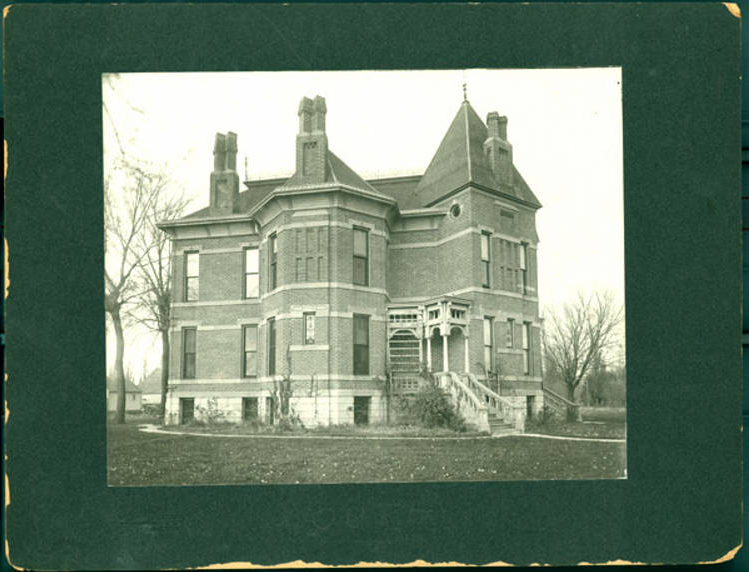
This is a 14” x 10.5” photograph of the home of Edward and Carrie Blewett, dated around 1900 – 1903. Located at 1217 Nye Ave. in Fremont, Nebraska; the home was built in 1884 and seems to suggest an eclectic style Victorian home with some loosely based Chateauesque influences. Some of the Chateauesque details include: very tall and ornate chimneys, the iron cresting and finials on the roof, the pyramid shaped hipped roof on the tower, the double belt courses which band the home, and the canopied entrance door. This home was purchased in 1903 by Frank Fowler and was heavily remodeled to create his Neoclassical style Westfield Acres.
This image is owned by the Dodge County Historical Society, and published by Keene Memorial Library. Both are located in Fremont, Nebraska, and they worked as partners to digitize and describe content owned by the historical society. The collection of photographs documents life in Fremont in the late 1800s and early 1900s.
See this collection and many more on the Nebraska Memories archive!
The Nebraska Memories archive is brought to you by the Nebraska Library Commission. If your institution is interested in participating in Nebraska Memories, see http://nlc.nebraska.gov/nebraskamemories/participation.aspx for more information.
Nebraska Library Commission Awards Grants for Youth Library Service

FOR IMMEDIATE RELEASE:
May 8, 2024
FOR MORE INFORMATION:
Sally Snyder
402-471-4003
800-307-2665
Nebraska Library Commission Awards Grants for Youth Library Service
The Nebraska Library Commission recently awarded $30,000 in grants for Excellence in Youth service. Of the grants awarded to thirty-nine Nebraska libraries, several addressed the need for educational programs, Summer Reading programing, and materials like LEGO®, STEAM, and other activities to encourage creativity in young people. The Nebraska Library Commission congratulates all the libraries who received grants as they develop new and innovative programs to ensure excellence in library service for Nebraska young people.
You can find the full list of grant recipients on the Nebraska Library Commission grants database.Proposals include:
- Adventure Backpacks
- STEAM programing and materials
- Book Club activities
- Tween Makerspace Camp
- Summer Reading programs
- Music and movement class
- Creative Coding for Kids
- Makerspace items for children/youth
- Builders’ Club with Lego
- 1000 Books Before Kindergarten
The following 39 Nebraska public libraries were awarded 2024 Youth Grants for Excellence funding:
Bancroft Public Library
Bayard Public Library
Beatrice Public Library
Bellevue Public Library
Broken Bow Public Library
Central City Public Library
Clearwater Public Library
Columbus Public Library
Hruska Public Library, David City
Elmwood Public Library
Falls City Library and Arts Center
Fullerton Public Library
Genoa Public Library
Grand Island Public Library
Hastings Memorial Library, Grant
Lincoln City Libraries
Louisville Public Library
Madison Public Library
Mead Public Library
Jensen Memorial Library, Minden
Norfolk Public Library
North Bend Public Library
CB Preston Memorial Library, Orleans
Osmond Public Library
Papillion Public Library
Plainview Public Library
Ravenna Public Library
St. Edward Public Library
Sargent Township Library
Shelton Public Library
Maxine White-Sutherland Public Library
Lied Tekamah Public Library
Valley Public Library
Valparaiso Public Library
Verdigre Public Library
Lied Lincoln Township Library, Wausa
Maltman Memorial Library, Wood River
Kilgore Memorial Library, York
Yutan Public Library
Youth Grants for Excellence are made available by the Nebraska Library Commission with funding from the State of Nebraska. As the state library agency, the Nebraska Library Commission is an advocate for the library and information needs of all Nebraskans. The mission of the Library Commission is statewide promotion, development, and coordination of library and information services, “bringing together people and information.”
###
The most up-to-date news releases from the Nebraska Library Commission are always available on the Library Commission Website, http://nlc.nebraska.gov/publications/newsreleases.
Posted in General, Grants, Library Management, Public Relations, Youth Services
Tagged Youth Grants for Excellence
Leave a comment
CCC Library Information Services Classes for Fall 2024

Central Community College announces class for the Library Information Services program for Fall 2024.
Enrollment opened April 19, 2024 for classes beginning August 19, 2024. The Library & Information Services Certificate is a 15-credit hour program. All credits can be applied to a Central Community College associate degree.
See details of classes and registration information at https://www.cccneb.edu/lis
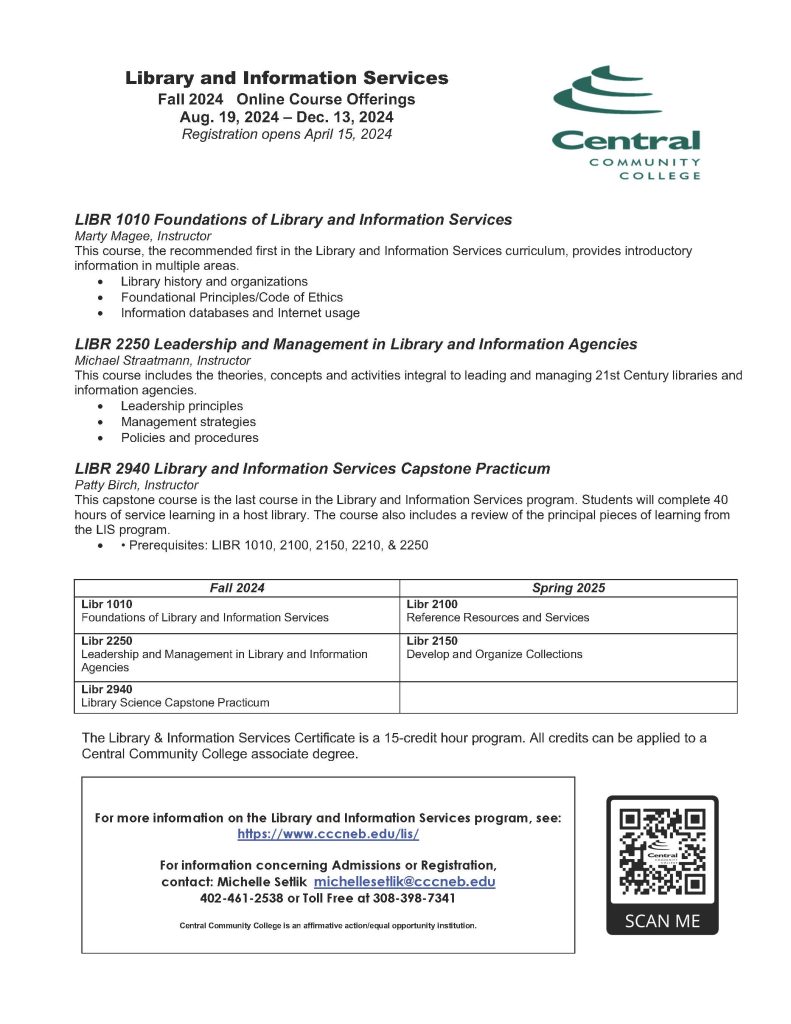
Over $6 Million in E-rate Funding Awarded to Nebraska Schools and Public Libraries
As of May 2, USAC has released two Waves of Funding Commitment Decision Letters (FCDLs) for E-rate Funding Year 2024. These Waves include $6,641,645.17 in funding commitments for 318 Nebraska school and public library applicants.
Congratulations to all Nebraska schools and public libraries who have been funded!
A list of public libraries who have received E-rate funding is on the NLC E-rate webpage. The 2024 list will be updated as new funding waves are announced.
If you haven’t received your FCDL yet, don’t panic! There are many more weekly Waves to come as USAC processes more applications. This is just the start of Funding Year 2024, more approvals are coming.
When your FCDL is ready, it will be attached as a printable PDF to the email notifying you that your FCDL has been issued. It will also be available in the Notifications section of your EPC account, but you are no longer required to log into your EPC account to view it.
IMPORTANT: As soon as you receive your FCDL, you should immediately go on to the next step in the E-rate process, filing your Form 486. This form is submitted in your EPC account. Information and instructions on how to do that can be found on the USAC website.
If you have any questions or need any assistance with your public library’s E-rate forms, visit the NLC E-rate webpage or contact Christa Porter, State E-rate Coordinator for Public Libraries, 800-307-2665, 402-471-3107.
Posted in Broadband Buzz, General, Library Management, Technology
Tagged e-rate, erate
Leave a comment
#BookFaceFriday “Between the Lines” by Nikki Grimes
Extra! Extra! Read all about this #BookFaceFriday!
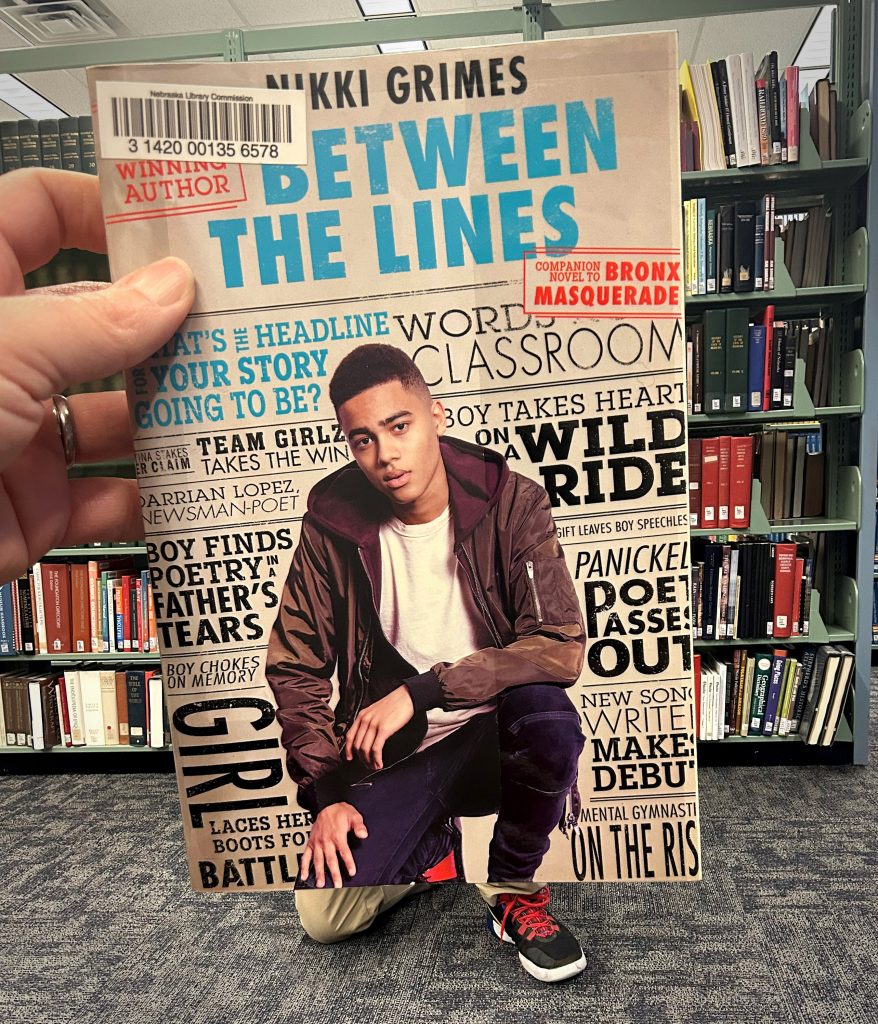
This week’s #BookFace is the 2024 selection for One Book for Nebraska Teens “Between the Lines” by Nikki Grimes (Nancy Paulsen Books, 2019).
In case you missed it, this week’s NCompass Live was all about our One Book for Nebraska Kids and Teens program, you can still watch the recording and find out all about the program on the NCompass Live webpage. This book is available as a part of our Book Club Kit collection; we have ten copies along with a discussion and activity guide. The Nebraska Library Commission has a large collection of children and young adult titles available to school and library book clubs. You can even search the collection based on grade level to find age and reading level appropriate books.“These complex students use poetry to find their truest voices and write their own stories. . . . Each character occupies his or her own space and no one character or voice monopolizes the story. The narratives of immigrants, foster children, families effected by incarceration, and teens taxed with familial burdens are thoroughly explored in a thought-provoking way. The poems and voices are a perfect blend of the many facets of American teens’ lives. An excellent companion book that lends itself easily to a teacher’s poetry unit, this is great choice for school and public libraries.”
—School Library Journal
Book Club Kits Rules for Use
- These kits can be checked out by the librarians of Nebraska libraries and media centers.
- Circulation times are flexible and will be based upon availability. There is no standard check-out time for book club kits.
- Please search the collection to select items you wish to borrow and use the REQUEST THIS KIT icon to borrow items.
- Contact the Information Desk at the Library Commission if you have any questions: by phone: 800/307-2665, or by email: Information Services Team
Love this #BookFace & reading? Check out our past #BookFaceFriday photos on the Nebraska Library Commission’s Facebook page!
Throwback Thursday: Girl Standing In Tree
Happy May #ThrowbackThursday!
This black and white photograph postcard is of a young girl in a light colored dress and tights. She’s posed up in the branches of a tree. The girl remains unidentified but appears to be one of the nieces of the photographer, John Nelson, who came to Nebraska with his parents at the age of seventeen from Sweden. His photographs tell the story of small town life in Nebraska during the first decades of the twentieth century. This postcard is from around 1907-1917.
This image is owned and published by History Nebraska. They digitized content from the John Nelson and the J. A. Anderson collection.
See this collection and many more on the Nebraska Memories archive!
The Nebraska Memories archive is brought to you by the Nebraska Library Commission. If your institution is interested in participating in Nebraska Memories, see http://nlc.nebraska.gov/nebraskamemories/participation.aspx for more information.
NLC Staff: Meet Laura Mooney
Questions and answers with NLC’s Government Services Administrative Technician, Laura Mooney. Take a few minutes and get to know her with a few fun questions!
What advice would you give your 21-year-old self?
Don’t worry so much about what other people think.
What is your ideal vacation?
Somewhere I can be outside and enjoy nature, but also experience the history, and learn something new.
What do you do to relax?
Watch TV, go for walks, cooking, baking, and gardening. I also love styling vintage clothing and dressing up just for fun. I often spend evenings researching various topics and daydreaming or planning home and garden projects, travel, etc.
Describe your first car?
A silver Pontiac Sunbird
If I weren’t working in a library, I’d be…
Traveling (if money were no object)
What was the first concert you remember attending?
Andy Gibb at the Oregon State Fair
What movie can you watch over and over again?
You’ve Got Mail
What was the last book you read?
Dark, Salt, Clear: Life in a Cornish Fishing Town by Lamorna Ash
What was the last movie you watched?
Tolkien
What is your proudest handyman moment?
Renovating the raised beds in my garden
Three words that describe you?
Quiet, curious, persistent
What smell brings back great memories?
The smell of grass rugs from my grandparent’s beach house
If you could have one superpower what would it be?
Teleporting
What’s the last thing you do before you got to bed?
Watch benign television
If you had a warning label, what would it say?
Messy when tired
What is your favorite comfort food?
Peanut butter – Smuckers Natural Creamy
What words or phrases do you overuse?
Umm and Like
What posters did you have on your wall as a kid?
The Monkees
Do you love or hate rollercoasters?
I didn’t have the opportunity to ride them as a kid but on my 40th birthday, I asked my dad and my husband to join me in riding a roller coaster at SeaWorld in San Diego.
Do you have any pets?
I grew up with dogs, cats, rabbits, chickens, ducks, and a cockatiel. My husband and I recently lost our cat Allie this past year.
What are your pleasures? (there are no guilty pleasures)
Dark chocolate
Favorite apps on your phone?
Texting and safari are probably most used. Instagram, podcasts, and Spotify are favorites.
If you could only eat one kind of food for the rest of your life, what would it be?
Mexican
What do you get every time you go to the grocery store?
Yogurt, but peanut butter when I need to restock. I can never run out of peanut butter!
Posted in General, Public Relations
Tagged Nebraska Library Commission Staff, NLC Staff, Staff
Leave a comment
#BookFaceFriday “Nothing but the Truth” by Avi
You can’t handle the #BookFace!
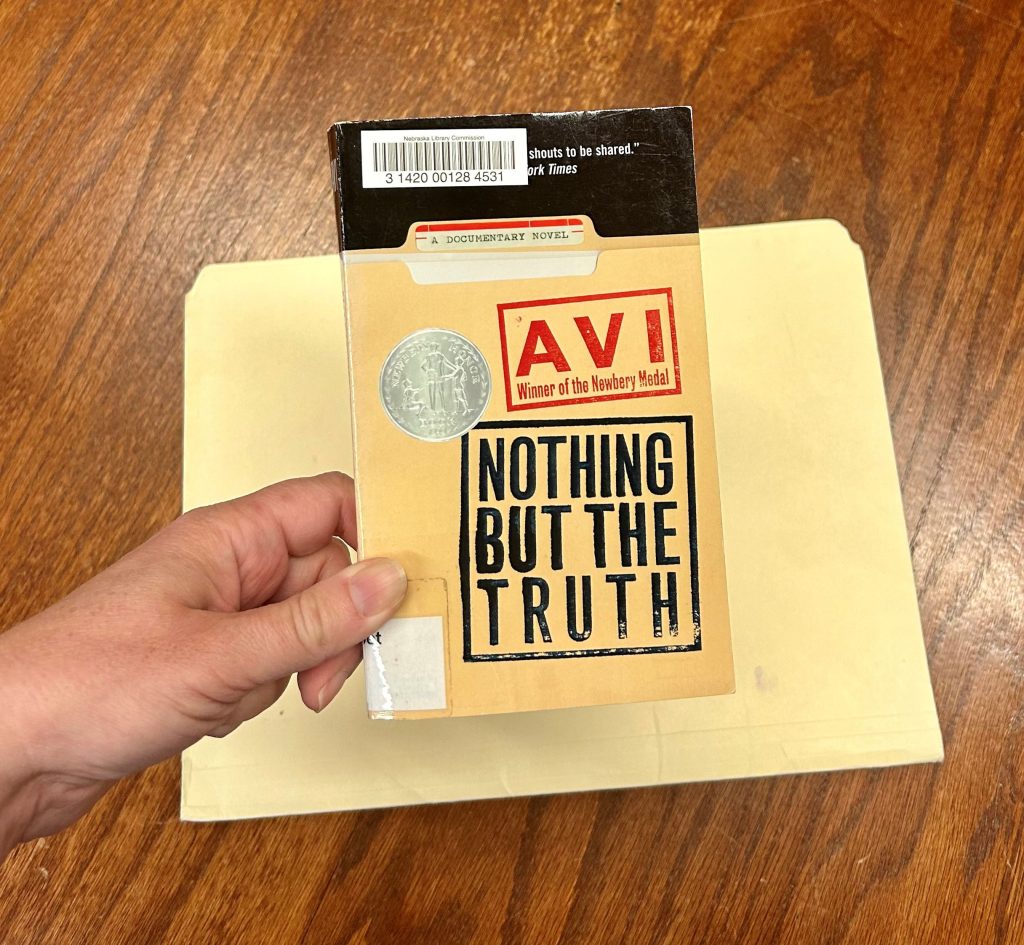
This week’s #BookFace is Newbery Honor Book, “Nothing but the Truth: A Documentary Novel” by Avi (Scholastic, 1991). It’s available as a part of our Book Club Kit collection; we have ten copies along with study questions.
The Nebraska Library Commission has a large collection of children and young adult titles available to school and library book clubs. You can even search the collection based on grade level to find age and reading level appropriate books.“Structured as a series of journal entries, memos, letters and dialogues, this highly original novel emerges as a witty satire of high school politics, revealing how truth can easily become distorted.”
—Publisher’s Weekly (Starred Review)
Book Club Kits Rules for Use
- These kits can be checked out by the librarians of Nebraska libraries and media centers.
- Circulation times are flexible and will be based upon availability. There is no standard check-out time for book club kits.
- Please search the collection to select items you wish to borrow and use the REQUEST THIS KIT icon to borrow items.
- Contact the Information Desk at the Library Commission if you have any questions: by phone: 800/307-2665, or by email: Information Services Team
While we don’t have this particular title available through Nebraska OverDrive Libraries, we do have a significant number of the author’s other works available. You can find twenty books by Avi in the Kids and Teens section. Libraries participating in the Nebraska OverDrive Libraries Group currently have access to a shared and growing collection of digital downloadable audiobooks and eBooks. 194 libraries across the state share the Nebraska OverDrive collection of 26,174 audiobooks, 36,611 ebooks, and 5,210 magazines. As an added bonus it includes 130 podcasts that are always available with simultaneous use (SU), as well as SU ebooks and audiobook titles that publishers have made available for a limited time. If you’re a part of it, let your users know about this great title, and if you’re not a member yet, find more information about participating in Nebraska Overdrive Libraries!
Love this #BookFace & reading? Check out our past #BookFaceFriday photos on the Nebraska Library Commission’s Facebook page!
Posted in Books & Reading, General, Youth Services
Tagged Avi, book club kit, Book Covers, bookfacefriday, libraries, Newbery Honor, Nothing but the Truth, Reading, YA books, Young Adult
Leave a comment
Friday Reads: The Last Man, by Mary Shelley, with a new foreword by Rebecca Solnit
When I read that Rebecca Solnit wrote a new foreword for a Mary Shelley book, and it was one I hadn’t read yet, The Last Man, I jumped to acquire the new Penguin edition. Solnit writes so eloquently on many topics close to my heart, and Shelley’s Frankenstein is one of my favorite books—I reviewed it for this blog some time ago, here.
We knew Mary Shelley invented the Frankenstein genre, of course, and is often credited (correctly, I would say) with writing the first science fiction novel when she did. It turns out that a few years later, she also wrote the first Western novel about human extinction, as well as the first book in the genre now known as “climate fiction.” When Shelley wrote this book, The Last Man, the skies over Europe were dark because of a volcanic eruption, a cholera epidemic was cutting swaths out of the human population, and England’s political parties were battling over the future identity of the country. The author was also dealing with terrible personal loss, including the recent death of her husband, the poet Percy Bysshe Shelley, and their special friend, the poet Lord Byron.
This dystopian novel, set in the late twenty-first century, was not well-received by critics or the general public when it was published in 1824, but modern readers find much to explore and enjoy here. (Perhaps the book was “ahead of its time” in more ways than one.) Shelley invented lore about “finding” secret writings in a cave in Naples that she fashioned into this text, with a story that runs from 2073-2100. The foreword to the 2024 edition, by Rebecca Solnit, expertly connects Shelley’s concerns with ours, two hundred years later.
If you’d like to read or listen to an earlier edition of this novel right this minute, you’re in luck, because it’s 200 years old so it’s definitely in the public domain! The Internet Archive has many options to read the work (here is one option for volume 1 of 3) and Librivox has free audio (here is one option). I appreciate how many wonderful texts and works are available through the Internet Archive—if you haven’t explored there, this is a great time to start.
And if you’re in Nebraska, we have a couple of editions (from 1993 and 2006), from University of Nebraska Press, in our circulating collection to check out. You can search our OPAC here to request a copy.
Shelley, M. W., Solnit, R., & Havard, J. O. (2024). The last man. Penguin Classics.
$21,000 in Internship Grants Awarded to Nebraska Public Libraries
FOR IMMEDIATE RELEASE:
April 25, 2024
FOR MORE INFORMATION:
Christa Porter
402-471-3107
800-307-2665
$21,000 in Internship Grants Awarded to Nebraska Public Libraries
The Nebraska Library Commission recently awarded Nebraska Library Internship Grants totaling $21,000 to eighteen Nebraska public libraries. These internship grants will support public library interns who will contribute to the scope and value of the diverse programs and activities in Nebraska’s public libraries.
“The internships are a great opportunity for students to get involved in library work. Beyond earning money and gaining valuable work experience, the student is exposed to the broad range of library services and programming. Internships provide an opportunity for the student to view the library as a viable and satisfying career choice. In addition, interns bring a fresh perspective and their own unique talents to the library,” said Nebraska Library Commission Director Rod Wagner.
Student interns will learn about library work as they shadow staff, assist with day-to-day library operations, and implement special projects. Some of the activities that students will participate in include:
- Summer Reading Programs for youth, teens, and adults
- Help plan and conduct makerspace classes, STEAM activities, story time, computer classes, and Pioneer Days events
- Assist with library outreach at the Farmer’s Market
- Partner with local historian to work in the Heritage Room
- Field trips to visit other public libraries
- Partnerships with the Community Club, Library Foundation, 4-H, FFA, and County Extension
- Basic library duties: circulation, shelving, weeding, attending library board and city/village council meetings, processing acquisitions
The following 18 Nebraska public libraries were awarded 2024 internship grant funding:
Atkinson Public Library
Axtell Public Library
Rock County Public Library, Bassett
Bayard Public Library
Garfield County Library, Burwell
Central City Public Library
Ceresco Community Library
Clearwater Public Library
Grand Island Public Library
Howells Public Library
Lincoln City Libraries – Loren Corey Eiseley Branch Library, Charles H. Gere Branch Library, Bennett Martin Public Library, Youth Services Outreach, Bess Dodson Walt Branch Library, Northeast Service Unit – Victor E. Anderson & Bethany Branch Libraries
Nancy Fawcett Memorial Library, Lodgepole
Orchard Public Library
Osmond Public Library
Palisade Public Library
Papillion Public Library
Stromsburg Public Library
Valley Public Library
Funding for the project is supported and administered by the Nebraska Library Commission, in partnership with the Nebraska Library Systems.
As the state library agency, the Nebraska Library Commission is an advocate for the library and information needs of all Nebraskans. The mission of the Library Commission is statewide promotion, development, and coordination of library and information services, “bringing together people and information.”
Nebraska’s Regional Library Systems consist of four non-profit corporations governed by boards representative of libraries and citizens in the region. The four systems were established to provide access to improved library services through the cooperation of all types of libraries and media centers within the counties included in each System area.
###
The most up-to-date news releases from the Nebraska Library Commission are always available on the Library Commission Website, http://nlc.nebraska.gov/publications/newsreleases.
Posted in General, Grants, Library Management, Public Relations
Tagged grants, Internship Grant, Library grants
Leave a comment
Throwback Thursday: Two Oaks
It’s the #ThrowbackThursday before Arbor Day!
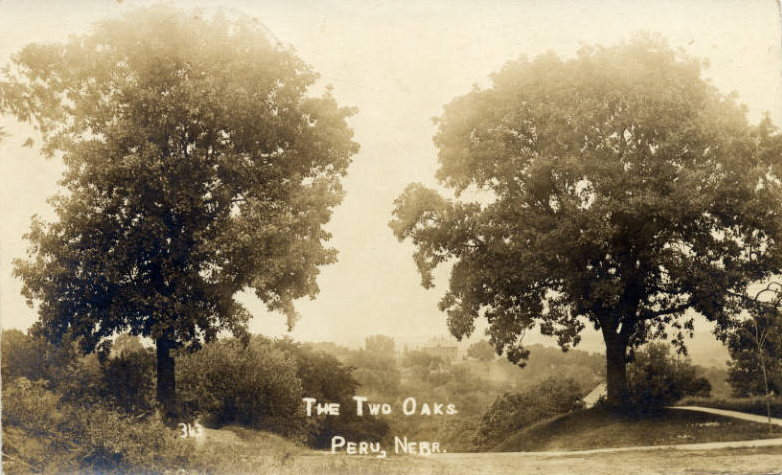
This sepia-toned 5-3/8” x 3-3/8” postcard is dated October 26, 1911; but the photograph of the two tall oak trees framing the view was likely from several years earlier. It appears to be taken from Mount Vernon Cemetery on Cemetery Hill to the east of Peru, Nebraska. You can see Mount Vernon Hall on the State Normal School campus in the distance. There is a one-cent Benjamin Franklin profile postage stamp on the back, along with this letter:
Peru Nebr.
R. E. Bailey
Oct 26 1911
7 AM
Miss Edna Livingston
Elgin
Nebr.
Hello! Am still in this vale of times[?] and sorrow. How is everything at Elgin? I am working hard this year, at present am carrying twenty four hours. Am teaching Phys Geo. in the ninth grade. Also getting some drill in making plans. I suppose the C.C. is still in Antelope Co? Have you played beast, bird or fish lately?
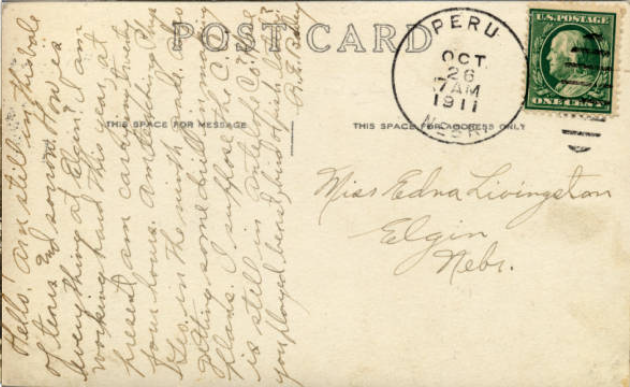
These images are published by the Nebraska Library Commission. Their collections include material on the history of libraries in the state of Nebraska, items from the 1930s related to the Nebraska Public Library Commission bookmobile, as well as items showcasing the history of Nebraska’s state institutions.
See this collection and many more on the Nebraska Memories archive!
The Nebraska Memories archive is brought to you by the Nebraska Library Commission. If your institution is interested in participating in Nebraska Memories, see http://nlc.nebraska.gov/nebraskamemories/participation.aspx for more information.
What’s Up Doc? New State Agency Publications at the Nebraska Library Commission
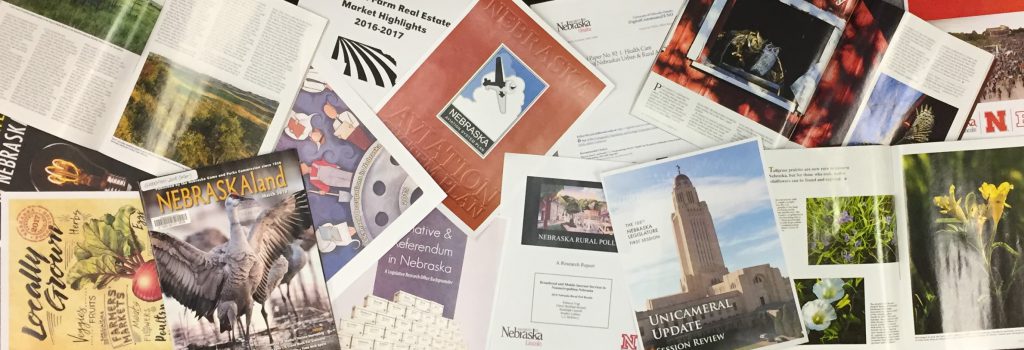
New state agency publications have been received at the Nebraska Library Commission for January and February, 2024. Included are reports from the Nebraska Bureau of Sociological Research, the Nebraska Foster Care Review Office, the Nebraska Department of Transportation, and the Nebraska Workers’ Compensation Court, to name a few.
Items are available for immediate viewing and printing by clicking directly in the .pdf below.
The Nebraska Legislature created the Nebraska Publications Clearinghouse in 1972 as a service of the Nebraska Library Commission. Its purpose is to collect, preserve, and provide access to all public information published by Nebraska state agencies. By law (State Statutes 51-411 to 51-413) all Nebraska state agencies are required to submit their published documents to the Clearinghouse. For more information, visit the Nebraska Publications Clearinghouse page, contact Mary Sauers, Government Information Services Librarian; or contact Bonnie Henzel, State Documents Staff Assistant.
Posted in Books & Reading, Education & Training, General, Information Resources, What's Up Doc / Govdocs
Tagged books, GovDocs, Reading
Leave a comment

